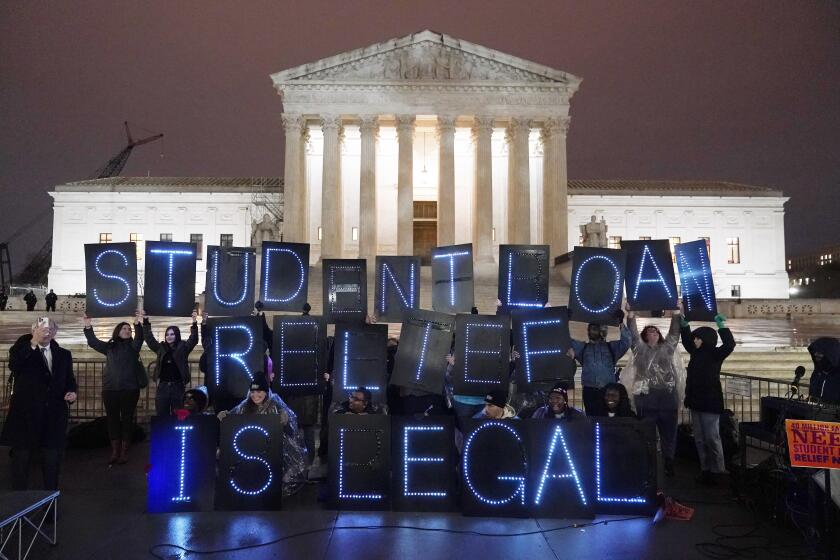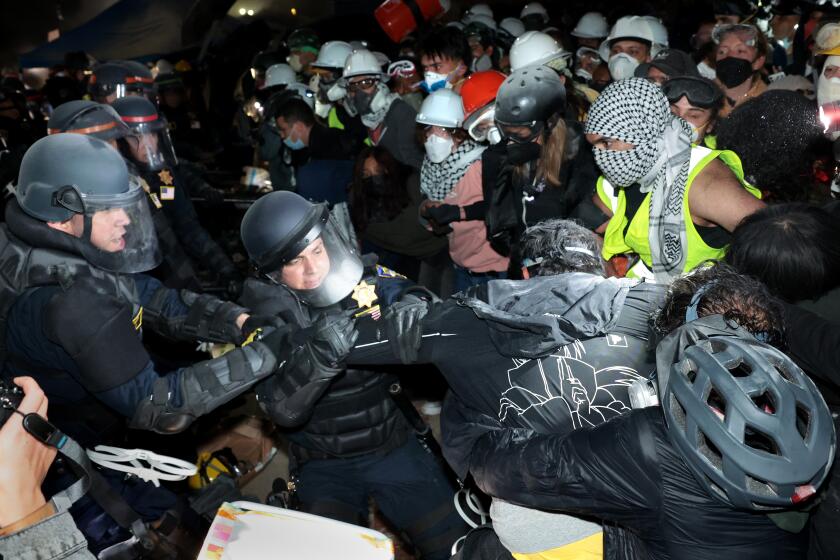Playa Vista School Plan Is Up in the Air
Its planners say the new Playa Vista development on Los Angeles’ Westside will be a hip version of a small town, with its own fire station, restaurants, public library, parks and exclusive ZIP Code: 90094.
What it lacks, however, is space for a public school, usually a touchstone for any real community.
As the first 400 of as many as 30,000 residents move into the nascent neighborhood, Playa Vista’s developers face the task of keeping their promise to provide four acres for a new elementary school while meeting the stringent environmental standards required for new Los Angeles Unified School District campuses.
The first proposed school site at Playa Vista includes land where Hughes Aircraft personnel used to drench plane fuselages with flammable liquids in firefighting drills. If chemical solvents in the ground can’t be cleaned up, an alternative school site may be offered. Another possibility is to scrap the Playa Vista school proposal and, instead, add onto existing campuses outside the development’s borders.
The Playa Vista school plan reflects the difficulty the school district faces as it begins its 10-year campaign to build 150 campuses in a region pocked by abandoned oil fields and naturally occurring underground gases. The district has become especially cautious since environmental problems nearly derailed the Belmont Learning Complex in downtown Los Angeles.
The Playa Vista school is also a test of the district’s resolve to knit new schools into the fabric of their communities.
“When you link schools to neighborhoods and neighborhoods to schools, you build identity,” said David Abel, chairman of New Schools/Better Neighborhoods, a nonprofit organization. “Playa could intelligently build a school that is at the center of the community from the very beginning.”
But if the district can’t make that happen in a neighborhood being built from scratch, observers wonder, what chance does it have in dozens of established communities around the city where homes and stores might have to be demolished to make room?
Conservationists have seized on the proposed school site to advance their long-standing objections to the entire Playa Vista development, which covers part of the former airplane production facility at the edge of the Ballona Wetlands.
Environmentalists unsuccessfully sought to block Playa Vista, saying the area should be preserved for wildlife and flood control. Still, the project’s scale has been reduced in the past year, with more acreage being designated as parkland even as the first apartments are opening.
In the neighborhoods just outside Playa Vista, residents worry that the planned K-8 campus will not be enough to accommodate rising student populations. Playa Vista developers estimate that the new neighborhood between Culver City and Marina del Rey will be home to 1,300 school-age students by 2006. District demographers say that number could be as high as 3,000 by the time the entire project is done in 10 years.
“We’re having a debate over a four-acre site when we really probably need two or three elementary schools and middle schools and a high school around there,” said David Tokofsky, a Los Angeles school board member.
Developer Robert Maguire first promised to provide about $16million in developer fees and a four-acre property to the district in 1993. Playa Capital, a group of investment bankers and lenders led by Global Crossing founder Gary Winnick and former mayoral candidate Steve Soboroff, now controls the property and says it will honor that agreement.
The proposed school site sits on the southwest side of the 1,087-acre Playa Vista project, east of Lincoln Boulevard near proposed athletic fields and an ecological and cultural information center.
Kathi Littmann, a senior L.A. Unified building official, raised early concerns about the property. She previously was a consultant for DreamWorks SKG when that company considered establishing a movie studio at Playa Vista. Littmann said her DreamWorks experience gave her “specific information” about possible pollution problems at the site.
In an October 2001 letter to the district’s general counsel, L.A. Unified real estate consultant Edwin Van Ginkel wrote that the site was “unacceptable ... due to acknowledged methane releases that have been identified in portions of the Playa Vista site.” In interviews, district officials said they were even more concerned about chemical solvents in the former fire pit.
Meanwhile, the district was trying to salvage the half-built Belmont high school, where revelations about underground toxins had halted construction for two years.
In March, the school board approved an extensive remediation plan to finish Belmont, ballooning that campus’ cost to $375million.
Eight days later, Littmann sent Playa Capital a clarification letter suggesting that the proposed elementary school site would work if it passed muster with the California Department of Toxic Substances Control.
In a phone interview last week, Soboroff downplayed hazards posed by methane and other toxins beneath the development, and said his firm will eventually provide a school property “that will meet every single standard for safety and environmental remediation.”
The developers also suggest that they might offer another nearby 4-acre site for a school. That second option would require some environmental mitigation for methane, they said, but chemical solvents are unlikely to be a problem.
If neither property is acceptable, district officials said they might devote developer fees from Playa Vista to pay for expansions and 160 classroom trailers at nine existing Westside campuses. That contingency plan calls for those schools to dramatically increase enrollments--some would double--and go to year-round schedules.
District officials say final decisions about the proposed Playa Vista school can wait.
“I’ve got 80 schools to finish now,” Littmann said. “This is not going to be a priority school until 2006.”
School board member Marlene Canter, who represents the area, said that if the site could be made safe, it would be a good idea to build a K-8 magnet school with an environmental studies theme to take advantage of the nearby wetlands preserve.
But she said a bigger issue for her constituents is overcrowding at nearby high schools. For example, Westchester High plans to set up 30 classroom trailers in its parking lot to absorb 700 additional students in the next two years.
School board member Tokofsky said Playa Vista should have been required to set aside much more land for schools, even for a high school.
Playa Capital executives said they never considered a high school because district negotiators never broached the subject. Canter and other L.A. Unified officials said they might bring it up.
Without any school there, Playa Vista’s upscale homes, offices, cafes and parks would still fall short of a real neighborhood, stressed Abel of New Schools/Better Neighborhoods.
“This is the perfect opportunity to make this school the public center of this new neighborhood, where youth can interact with an array of adults,” said Abel.
Relatively small schools close to homes strengthen community ties and improve student outcomes, he said.
“The public has to feel like they own that institution,” Abel said.
More to Read
Sign up for Essential California
The most important California stories and recommendations in your inbox every morning.
You may occasionally receive promotional content from the Los Angeles Times.






